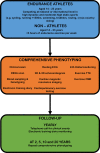Rationale and design of the PROspective ATHletic Heart (Pro@Heart) study: long-term assessment of the determinants of cardiac remodelling and its clinical consequences in endurance athletes
- PMID: 35368514
- PMCID: PMC8935177
- DOI: 10.1136/bmjsem-2022-001309
Rationale and design of the PROspective ATHletic Heart (Pro@Heart) study: long-term assessment of the determinants of cardiac remodelling and its clinical consequences in endurance athletes
Abstract
Background: Exercise-induced cardiac remodelling (EICR) results from the structural, functional and electrical adaptations to exercise. Despite similar sports participation, EICR varies and some athletes develop phenotypic features that overlap with cardiomyopathies. Training load and genotype may explain some of the variation; however, exercise 'dose' has lacked rigorous quantification. Few have investigated the association between EICR and genotype.
Objectives: (1) To identify the impact of training load and genotype on the variance of EICR in elite endurance athletes and (2) determine how EICR and its determinants are associated with physical performance, health benefits and cardiac pathology.
Methods: The Pro@Heart study is a multicentre prospective cohort trial. Three hundred elite endurance athletes aged 14-23 years will have comprehensive cardiovascular phenotyping using echocardiography, cardiac MRI, 12-lead ECG, exercise-ECG and 24-hour-Holter monitoring. Genotype will be determined using a custom cardiomyopathy gene panel and high-density single-nucleotide polymorphism arrays. Follow-up will include online tracking of training load. Cardiac phenotyping will be repeated at 2, 5, 10 and 20 years.
Results: The primary endpoint of the Pro@Heart study is the association of EICR with both training load and genotype. The latter will include rare variants in cardiomyopathy-associated genes and polygenic risk scores for cardiovascular traits. Secondary endpoints are the incidence of atrial and ventricular arrhythmias, physical performance and health benefits and their association with training load and genotype.
Conclusion: The Pro@Heart study is the first long-term cohort study to assess the impact of training load and genotype on EICR.
Trial registration number: NCT05164328; ACTRN12618000716268.
Keywords: Athlete; Elite performance; Exercise; Genetics; Heart disease.
© Author(s) (or their employer(s)) 2022. Re-use permitted under CC BY-NC. No commercial re-use. See rights and permissions. Published by BMJ.
Conflict of interest statement
Competing interests: None declared.
Figures


References
Associated data
LinkOut - more resources
Full Text Sources
Medical
